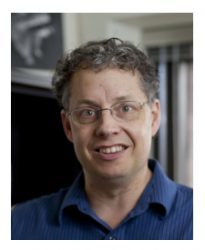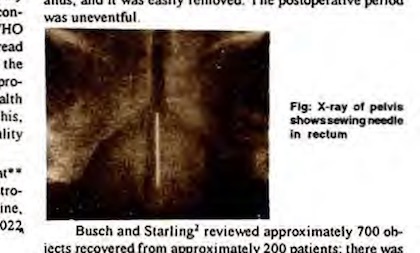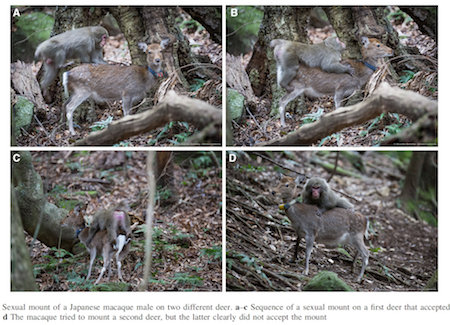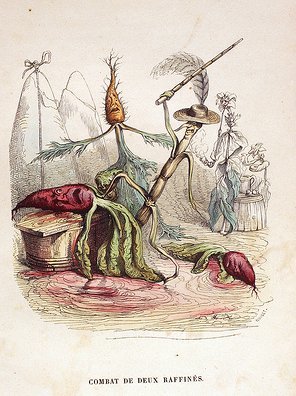Marc Abrahams's Blog, page 232
January 15, 2017
Paper airplane machine
This paper airplane machine makes and launches paper airplanes.
(Thanks to Keren Schlomy for bringing it to our attention.)

January 14, 2017
University Course Proposal: “Calling Bullshit”
Professors Carl T. Bergstrom and Jevin West from University of Washington have developed a new interdisciplinary course with the compelling title of Calling Bullshit.
From publication bias to fake news, bullshit is everywhere. And it’s important to be able to navigate it, separate delusion from reality, and call out bullshit when we see it. In a post-truth world, we need evidence and facts more than ever, and Professors Bergstrom and West have decided to do something about it.

Prof. Jevin West
As they write: “We’re sick of it. It’s time to do something, and as educators, one constructive thing we know how to do is to teach people. So, the aim of this course is to help students navigate the bullshit-rich modern environment by identifying bullshit, seeing through it, and combatting it with effective analysis and argument.”
Naturally, if people learn how to detect subtle bullshit that might otherwise go under their radar, that also can make them better at producing bullshit. Bergstrom and West recognize this possibility: “As with biological weapons, there is no such thing as purely defensive bullshit research.” Like them, however, we see far more positives than negatives in educating people to become more effective at distinguishing bullshit from evidence and fact.

Prof. Carl Bergstrom
“Calling Bullshit” (whose subtitle is “In the Age of Big Data”) isn’t yet part of a course catalog, but Professors Bergstrom and West have assembled a great selection of reading, and hopefully it will be an “official” offering soon. Their aim is to teach people “to think critically about the data and models that constitute evidence in the social and natural sciences” — in other words, to spot bullshit.
We encourage everybody to look at the course materials and fight for evidence and reasonable discourse (and for the right to party). Professor Bergstrom is in the Department of Biology and Professor West is in the Information School, so clearly bullshit crosses disciplinary boundaries, and their course promises to be both fascinating and educational.
(Thanks to investigators at the Bansal Lab for bringing this course to our attention.)
Closely related: In 2016, the Ig Nobel Peace Prize was awarded to the authors of the paper On the Reception and Detection of Pseudo-Profound Bullshit.

January 12, 2017
Least Interesting Units: a new concept for enhancing one’s academic career opportunities
 In these days where ‘Publish or Perish’ pressures are rife in academia, scholars who wish to enhance their career opportunities might want to turn to the work of dr.ir. Marcoen J.T.F. Cabbolet, who is a research affiliate at the Free University of Brussels. In a new paper for the journal Science and Engineering Ethics he suggests the liberal application of Least Interesting Units (LIUs) in research – in other words the importance of prioritising investigations that are only just interesting enough to pursue.
In these days where ‘Publish or Perish’ pressures are rife in academia, scholars who wish to enhance their career opportunities might want to turn to the work of dr.ir. Marcoen J.T.F. Cabbolet, who is a research affiliate at the Free University of Brussels. In a new paper for the journal Science and Engineering Ethics he suggests the liberal application of Least Interesting Units (LIUs) in research – in other words the importance of prioritising investigations that are only just interesting enough to pursue.
He presents the concept in the form of a maxim :-
“Maxim 6. A researcher should pursue as many LIUs as possible.”
with the observation that :
“[…] this maxim yields an enhanced career perspective in the current `publish-or-perish’ world that academia has become.”
See: ‘The Least Interesting Unit: A New Concept for Enhancing One’s Academic Career Opportunities’ in : Science and Engineering Ethics December 2016, Volume 22, Issue 6, pp 1837–1841.
It should be emphasised however, that although Dr. Cabbolet suggests this as a viable strategy, he doesn’t necessarily regard it as ethical behaviour :
“[…] giving up on the grand ideas is not just a defeatist attitude, it also harms science itself. Of course, most of the grand ideas turn out to be wrong or not feasible, but it is precisely these rare cases where such ideas led to tangible results that have virtually completely determined the entire historical development of science. And even if such a grand idea turns out to be wrong, it can still remain useful. Taking this view, while a certain number of LIUs is not necessarily a bad thing, scientific progress would be undermined if fulfilling Maxim 6 would become the new norm in science.”
A full copy of the paper may be found here.

January 11, 2017
And Now, a Needle in the Rectum (podcast #97)
What do doctors do when they find a needle in a patient’s rectum? A research study explores that very question, and we explore that study, in this week’s Improbable Research podcast.
SUBSCRIBE on Play.it, iTunes, or Spotify to get a new episode every week, free.
This week, Marc Abrahams discusses a published oh-look-there’s-a-needle-in-this-patient’s-rectum study. Yale/MIT/Harvard biomedical researcher Chris Cotsapas lends his voice, and his scientific expertise, and his opinions —with dramatic readings from a research study you may have overlooked.
For more info about what we discuss this week, go explore:
“And Now, a Needle in the Rectum,” Naresh K. Soni, Ashwini Gupta, and Narayan S. Shekhawat, Indian Journal of Gastroenterology, vol. 16, no. 2, April 1997, pp. 77–8.
The mysterious John Schedler or the shadowy Bruce Petschek perhaps did the sound engineering this week.
The Improbable Research podcast is all about research that makes people LAUGH, then THINK — real research, about anything and everything, from everywhere —research that may be good or bad, important or trivial, valuable or worthless. CBS distributes it, on the CBS Play.it web site, and on iTunes and Spotify).

January 10, 2017
When a monkey loved a deer…
Love has always been difficult to define exactly. A newly published study adds nuance, or at least data, to the concept. The study is:
“Interspecies sexual behaviour between a male Japanese macaque and female sika deer,” Marie Pelé, Alexandre Bonnefoy, Masaki Shimada, and Cédric Sueur, Primates, epub January 2017. The authors, in Strasbourg, France and Uenohara, Japan, report:
“Interspecies sexual behaviour or ‘reproductive interference’ has been reported across a wide range of animal taxa. However, most of these occurrences were observed in phylogenetically close species… Only one scientific study has reported this phenomenon, describing sexual harassment of king penguins by an Antarctic fur seal. This is the first article to report mating behaviour between a male Japanese macaque (Macaca fuscata yakui) and female sika deer (Cervus nippon yakushimae) on Yakushima Island, Japan. Although Japanese macaques are known to ride deer, this individual showed clearly sexual behaviour towards several female deer, some of which tried to escape whilst others accepted the mount.”
Here’s pictorial detail from the study:

The penguin/seal study, mentioned above, is: de Bruyn PN, Tosh CA, Bester MN (2008) “Sexual harassment of a king penguin by an Antarctic fur seal,” Journal of Ethology, 26:295–297.)
(Thanks to Reto Schneider for bringing this to our attention.)

January 9, 2017
An Iconography of Carrots
 Authors John Stolarczyk and Jules Janick present their assessment of Carrot History and Iconography in the scholarly journal Chronica Horticulturae© (volume 51 – Number 2; June 2011).
Authors John Stolarczyk and Jules Janick present their assessment of Carrot History and Iconography in the scholarly journal Chronica Horticulturae© (volume 51 – Number 2; June 2011).
A great deal of further information can be found at John Stolarczyk’s World Carrot Museum which has a section devoted to Carrots Depicted in the Fine Arts.
More on carrot iconography here
Note: The illustration is ‘Combat de deux Raffinés’ (Fight of two debonaires) (at least one being a carrot) by Jean Ignace Isidore Gérard Grandville (1803-47)

January 8, 2017
Alwynne B. Beaudoin’s compost of dung research
Alwynne B. Beaudoin’s “The Dung File” is one of the more effusive collections of research about dung. Beaudoin says:
“The Dung File consists of a list of references dealing with pollen, parasites, and plant remains in coprolites and latrine fills from archaeological and palaeoenvironmental sites. The focus is on studies in North America, although the list also includes studies from many other areas. About 48% of the citations are from areas other than North America. The list includes mostly publications in the English language.”
The Dung File has a logo:
Who is Alwynne B. Beaudoin? Dr. Alwynne. B. Beaudoin is Head Curator, Earth Sciences, and Curator, Quaternary Environments, at the Royal Alberta Museum. That’s who.
(Thanks to Dan Odell for bringing this to our attention.)
 UPDATE (January 8, 2017): Inéz López-Dóriga alerts us to the existence of a different list of dung research citations: “An Idiosyncratic and Not Exhaustive Bibliography for Animal Dung and Archaeology,” accumulated by Naomi F. Miller (pictured here) of the University of Pennsylvania Museum. López-Dóriga alerts us also to the National Poo Museum, the contents of which are deposited in the museum, which is on the Isle of Wight.
UPDATE (January 8, 2017): Inéz López-Dóriga alerts us to the existence of a different list of dung research citations: “An Idiosyncratic and Not Exhaustive Bibliography for Animal Dung and Archaeology,” accumulated by Naomi F. Miller (pictured here) of the University of Pennsylvania Museum. López-Dóriga alerts us also to the National Poo Museum, the contents of which are deposited in the museum, which is on the Isle of Wight.

January 7, 2017
Nominative Determinism: Harry Beaver, gynecologist. Also: Bush and Blinder.
Three more doctors who benefit/suffer from nominative determinism:
Harry Beaver [pictured here], gynecologist.
Kevin Blinder, ophthalmologist.
(Thanks to anonymous person for bringing these to our attention.)

January 6, 2017
“Less children per man than per woman”
This week’s Recent Headline of the Week: “Less children per man than per woman“.
That headline runs atop a December 20, 2016 report from Max-Planck-Gesellschaft, in Munich.
(Thanks to H.H. Schwab for bringing this to our attention.)

January 5, 2017
Moles : Why do we have them? – A theory
Patient: “Doctor, why do we get moles in the first place?”
Physician: “No one has the foggiest notion why God gave us moles on our skin … and that’s the honest truth.”
 There are theories however – the most prominent being that the extra melanin produced in the moles’ melanocytes might help to protect against UV radiation. Not everyone agrees though – take for example Professor Craig Burkhart and colleague Professor Craig Burkhart who explain their ‘Mole Theory’ in the International Journal of Dermatology, 44, 340–342. They point out that in humans, extra deposits of melanin are often found in bodily areas where the sun very rarely (if ever) shines. Moreover, many nocturnal animals, “are highly melanized on their exterior surface.” In light of this the team offer another hypothesis :
There are theories however – the most prominent being that the extra melanin produced in the moles’ melanocytes might help to protect against UV radiation. Not everyone agrees though – take for example Professor Craig Burkhart and colleague Professor Craig Burkhart who explain their ‘Mole Theory’ in the International Journal of Dermatology, 44, 340–342. They point out that in humans, extra deposits of melanin are often found in bodily areas where the sun very rarely (if ever) shines. Moreover, many nocturnal animals, “are highly melanized on their exterior surface.” In light of this the team offer another hypothesis :
“ […] melanocytes are not simply pigment-producing cells, but produce substances with a range of biological functions, including structural strengthening by cross-linking proteins, antimicrobial defense, photon shielding, and chemoprotection. Thus, God gave us melanocytic and moles to provide several physiologically significant functions, including the provision of communicatory links with several different systems, e.g. the skin, central nervous system, and immune/ inflammatory responses.”

Marc Abrahams's Blog
- Marc Abrahams's profile
- 14 followers





